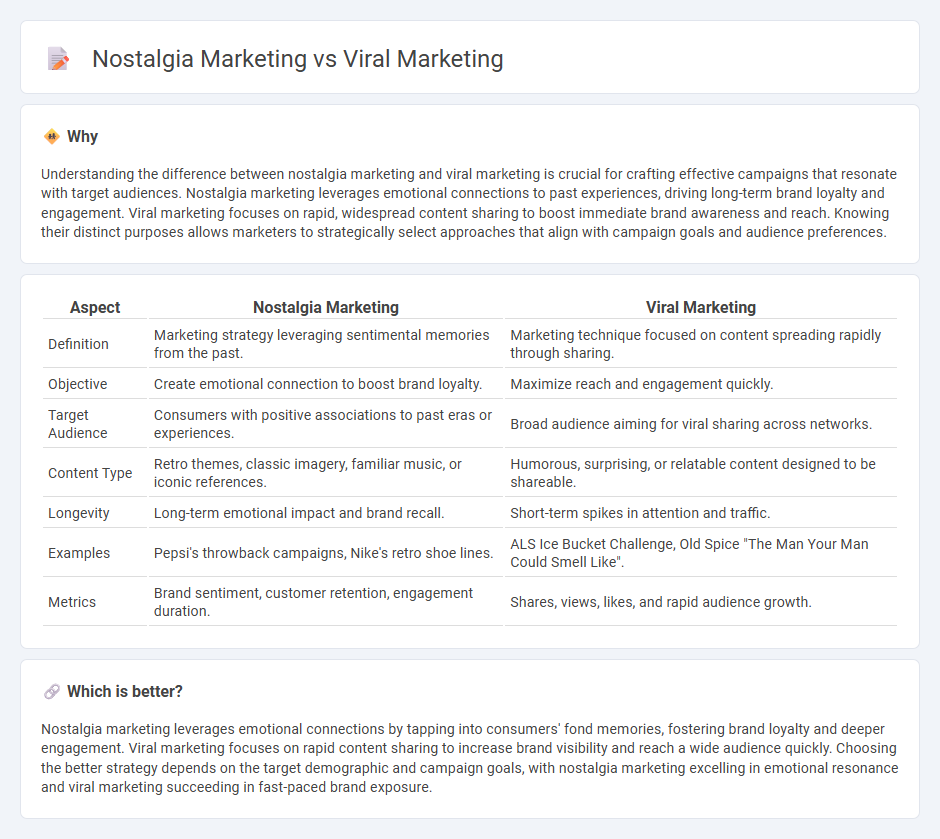
Nostalgia marketing leverages consumers' emotional connections to past experiences by integrating familiar themes, symbols, or cultural references into campaigns, creating a sense of comfort and brand loyalty. Viral marketing focuses on crafting highly shareable content designed to rapidly spread across social media platforms, maximizing reach and engagement through user participation and network effects. Explore in-depth strategies and case studies to understand how each approach drives consumer behavior and brand growth.
Why it is important
Understanding the difference between nostalgia marketing and viral marketing is crucial for crafting effective campaigns that resonate with target audiences. Nostalgia marketing leverages emotional connections to past experiences, driving long-term brand loyalty and engagement. Viral marketing focuses on rapid, widespread content sharing to boost immediate brand awareness and reach. Knowing their distinct purposes allows marketers to strategically select approaches that align with campaign goals and audience preferences.
Comparison Table
| Aspect | Nostalgia Marketing | Viral Marketing |
|---|---|---|
| Definition | Marketing strategy leveraging sentimental memories from the past. | Marketing technique focused on content spreading rapidly through sharing. |
| Objective | Create emotional connection to boost brand loyalty. | Maximize reach and engagement quickly. |
| Target Audience | Consumers with positive associations to past eras or experiences. | Broad audience aiming for viral sharing across networks. |
| Content Type | Retro themes, classic imagery, familiar music, or iconic references. | Humorous, surprising, or relatable content designed to be shareable. |
| Longevity | Long-term emotional impact and brand recall. | Short-term spikes in attention and traffic. |
| Examples | Pepsi's throwback campaigns, Nike's retro shoe lines. | ALS Ice Bucket Challenge, Old Spice "The Man Your Man Could Smell Like". |
| Metrics | Brand sentiment, customer retention, engagement duration. | Shares, views, likes, and rapid audience growth. |
Which is better?
Nostalgia marketing leverages emotional connections by tapping into consumers' fond memories, fostering brand loyalty and deeper engagement. Viral marketing focuses on rapid content sharing to increase brand visibility and reach a wide audience quickly. Choosing the better strategy depends on the target demographic and campaign goals, with nostalgia marketing excelling in emotional resonance and viral marketing succeeding in fast-paced brand exposure.
Connection
Nostalgia marketing leverages emotional connections to past experiences, creating memorable content that resonates deeply with audiences and increases shareability. Viral marketing amplifies this effect by rapidly spreading nostalgic content through social media platforms, enhancing brand visibility and engagement. The synergy between these strategies maximizes audience reach by triggering sentimental responses that encourage organic sharing and customer loyalty.
Key Terms
**Viral Marketing:**
Viral marketing leverages highly shareable content designed to rapidly spread across social media platforms, exponentially increasing brand exposure and engagement. Key elements include emotional appeal, timeliness, and platform-specific optimization, resulting in swift audience growth and increased conversions. Explore how viral marketing strategies can transform your brand's online presence today.
Shareability
Viral marketing leverages highly shareable, emotionally engaging content designed to spread rapidly across social media platforms, maximizing brand visibility and user interaction. Nostalgia marketing capitalizes on consumers' emotional connections to past experiences, encouraging sharing through relatable and heartfelt triggers tied to memories. Explore the distinct strategies to enhance your marketing campaign's shareability and emotional impact.
Network Effects
Viral marketing leverages Network Effects by encouraging rapid sharing across social media platforms, maximizing reach through user-to-user interactions and exponential growth in brand visibility. Nostalgia marketing capitalizes on emotional connections tied to past experiences, triggering engagement by resonating with audiences' fond memories, which also amplifies sharing within specific communities. Explore how combining Network Effects with emotional triggers enhances overall marketing strategy effectiveness.
Source and External Links
Viral marketing - Wikipedia - Viral marketing is a business strategy that uses existing social networks to promote a product mainly on social media platforms by encouraging consumers to spread information like a virus, often via word of mouth or digital sharing, aiming to reach individuals with high social networking potential rapidly.
How to Use Viral Marketing To Get Consumers' Attention - Shopify - Viral marketing involves creating content, typically videos, designed to spread quickly through organic word of mouth and social sharing on social media, reaching a large audience without relying on paid ads.
Viral Marketing: Advantages, Disadvantages, Examples and FAQs - GeeksforGeeks - Viral marketing uses captivating, share-worthy content to leverage social media and word-of-mouth for rapid, exponential reach, relying on the audience's natural motivation to share messages within their networks.
 dowidth.com
dowidth.com